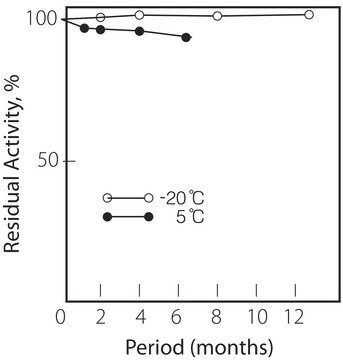Kluczowe dokumenty
G0774
Glycerokinase from Bacillus stearothermophilus
buffered aqueous solution, ≥75 units/mg protein (biuret)
Synonim(y):
ATP:glycerol 3-phosphotransferase, Glycerol Kinase
About This Item
Polecane produkty
pochodzenie biologiczne
Bacillus sp. (Bacillus steaarothermophilus)
Poziom jakości
Próba
≥5.0 mg protein/mL (biuret)
Formularz
buffered aqueous solution
aktywność właściwa
≥75 units/mg protein (biuret)
warunki przechowywania
dry at room temperature
kolor
beige
Zastosowanie
life science and biopharma
temp. przechowywania
2-8°C
informacje o genach
Bacillus sp. ... glpK(89613566)
Szukasz podobnych produktów? Odwiedź Przewodnik dotyczący porównywania produktów
Opis ogólny
Glycerol kinase is encoded by the GK gene on chromosome Xp21.2. Glycerol kinase is predominantly active in the liver.
Zastosowanie
Działania biochem./fizjol.
Definicja jednostki
Postać fizyczna
Hasło ostrzegawcze
Danger
Zwroty wskazujące rodzaj zagrożenia
Zwroty wskazujące środki ostrożności
Klasyfikacja zagrożeń
Resp. Sens. 1
Kod klasy składowania
11 - Combustible Solids
Klasa zagrożenia wodnego (WGK)
WGK 3
Temperatura zapłonu (°F)
Not applicable
Temperatura zapłonu (°C)
Not applicable
Środki ochrony indywidualnej
Eyeshields, Gloves, type N95 (US)
Wybierz jedną z najnowszych wersji:
Masz już ten produkt?
Dokumenty związane z niedawno zakupionymi produktami zostały zamieszczone w Bibliotece dokumentów.
Klienci oglądali również te produkty
Nasz zespół naukowców ma doświadczenie we wszystkich obszarach badań, w tym w naukach przyrodniczych, materiałoznawstwie, syntezie chemicznej, chromatografii, analityce i wielu innych dziedzinach.
Skontaktuj się z zespołem ds. pomocy technicznej










